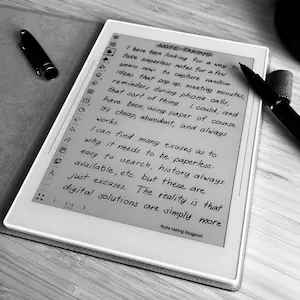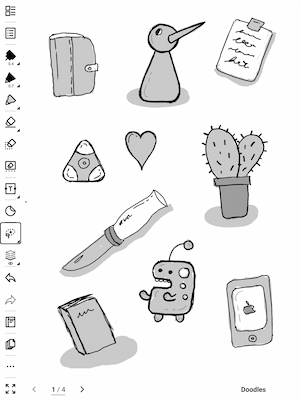Paperless note-taking
From an iPad mini to the Supernote Nomad.

I’ve been on the hunt for a paperless note-taking solution for a while now. I needed something to capture random ideas, jot down meeting minutes, or take quick reminders during phone calls. Of course, I could just use paper—and I have been. It’s cheap, abundant, and it always works. I can come up with many excuses as to why my note-taking needs to be digital (easy to search, history always available, etc.), but these are just rationalizations. The reality is that digital gadgets are simply more fun.
Version 1: The iPad mini
I had been eyeing the reMarkable tablet since it first launched back in 2017, but I never pulled the trigger. Two years later, in 2019, I bought an iPad mini (€459) with an Apple Pencil (€59) instead. I was a bit reluctant since I’m a sucker for all things e-paper, but I figured the iPad was a better deal as it’s a more capable device.
Looking back now, it was the right call, but not for the reason I expected. The 6-year old iPad still sees daily use. I use it for video calls, watching the occasional movie, browsing the web, and my son even plays games on it. The one thing I don’t use it for? Note-taking, the very reason I bought it! The feeling of the pencil on the glass screen just doesn’t feel right, and the pencil’s battery is predictably dead every time I actually want to use it.
To summarize: yes, the iPad gets lots of use, but not for its original purpose in my life.
Version 2: Supernote Nomad
Fast forward to last week. My interest was piqued once more when reMarkable released a new, smaller version of their tablet. This led me down a rabbit hole where I found the Supernote Nomad, a competitor. Its main selling point over the reMarkable? The lack of a monthly subscription. I am allergic to subscriptions, and this was always the deal-breaker with the reMarkable.
My Supernote Nomad (€280), Heart of Metal 2 Pen (€75), and folio (€49) arrived last week. I’ve been using it to take notes during meetings, doodle, and write the draft of this blog post. It’s the complete opposite of the iPad; its features are limited, and that’s intentional. It’s a device designed for one thing: writing.

Here are my initial thoughts:
- The Writing Experience: The display is gorgeous and designed to mimic paper. While writing on it feels much better than the iPad, I personally wouldn’t compare it to real paper. It’s very responsive—traditionally a weakness for E Ink—but the surface feels a little too smooth to be a true paper replacement.
- The Pen: The pen does not have a battery. This is a big deal, as it means it will always be ready to use. Unlike the reMarkable, the tips are designed not to need replacing. This is more convenient, though I can’t compare the writing feel to the reMarkable pen. The Supernote pens also don’t come with an eraser, which would have been handy.
- Openness and Connectivity: The Supernote works fully offline. There’s no account required, no tracking or ads, and no vendor lock-in. You can create a Supernote account for optional syncing and free cloud storage, but you don’t have to. It also supports Dropbox, Google Drive, and OneDrive. WebDAV, my personal choice, is on their roadmap. For local transfers, you can connect over Wi-Fi, use a USB cable, or just pop out the SD card.
- No Color: The Supernote doesn’t have a color display like the small reMarkable, but while that feature would be nice, I don't expect to miss it. The Supernote is also about €100 cheaper with similar accessories.
- Company Ethos: reMarkable is a Norwegian company, while Supernote is based in Singapore and Japan. I try to buy “European” when possible, so reMarkable would have had the advantage here if it weren’t for their subscription model. However, the company behind Supernote, Ratta, seems great. They publish their development roadmap and support the right-to-repair movement by selling replacement parts. You can even assemble your own pen. They also claim not to run promotions or sales to prevent impulse buying.
It’s only been a week, but so far I’m impressed by the openness of the platform and the ethos of the company. E-notebooks are pricey, especially when compared to good old paper. Is it worth the cost? It’s too soon to tell, but it’s off to a strong start.